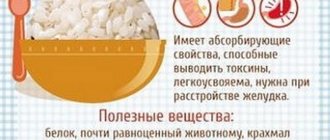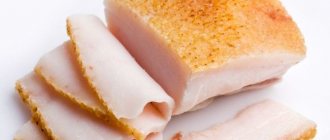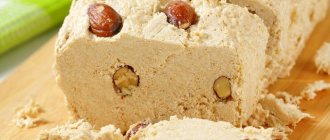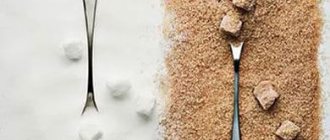Buckwheat porridge is one of the safest cereals for breastfeeding. Pediatricians recommend that nursing mothers start eating porridge with buckwheat. Buckwheat porridge is useful for anemia and lactation. It is quickly and easily absorbed, improves the condition of the skin, teeth and hair. But even when consuming such a healthy product, a nursing mother needs to limit her consumption of the dish and not overeat. In addition, pediatricians do not recommend eating buckwheat with milk.
Can mothers use it during breastfeeding?
Buckwheat is rich in vitamins and minerals, is easily digestible, and gives a feeling of lightness. Regarding whether it is possible to eat buckwheat while breastfeeding and mixed feeding, cereals are included in the category of products that are not only allowed during lactation, but also recommended for consumption by a nursing mother.
From what month, and in what form should I use it?
Buckwheat is included in the diet from the first days of a newborn’s life; this is done gradually, carefully monitoring the child’s condition. In the first month, cereals are eaten in the form of porridge, steamed or boiled in water. It is not recommended to add salt, sugar, milk, berries, fruits and butter to the dish. Cereals can be used as a side dish for meat, vegetable and fish dishes, in soups, casseroles, etc.
They begin to introduce the product into the diet with 1-2 tablespoons, and after eating they monitor the baby’s condition. If negative symptoms have not appeared within 48 hours (excessive gas formation, rash, etc.), the volume is increased every day to the recommended daily intake - 150 g. If the child has a negative reaction to cereal, the administration is postponed for 1-3 months so that his gastrointestinal tract is filled with the necessary enzymes and beneficial bacteria for proper digestion of food.
The benefits of cereals
Buckwheat for a breastfeeding mother is a source of iron, calcium, phosphorus, iodine, oxalic acid, fiber and other useful microelements, as well as vitamins. Regular use of the product:
- increases hemoglobin, improves blood clotting;
- stabilizes the functioning of the central nervous system, increases resistance to stress;
- improves the condition of skin, nails and hair;
- strengthens the immune system;
- regulates metabolic processes;
- strengthens bones and tooth enamel;
- improves the functioning of the thyroid gland, cleanses the body of toxins;
- supports the functioning of the cardiovascular system, strengthens the walls of blood vessels;
- provides prevention of hypertension, diabetes;
- supports the functioning of the gastrointestinal tract, normalizes microflora, eliminates constipation;
- accelerates the process of fat dissolution, promotes weight loss.
Pediatricians recommend consuming buckwheat porridge during pregnancy and breastfeeding. Compared to other types of cereals, it has a number of advantages:
- Rarely causes allergic reactions. It contains no allergenic components or gluten. Contains vitamin PP, which is an antiallergic agent.
- It is easily absorbed and digested, does not overload the stomach, all beneficial substances quickly enter the blood and milk of a nursing mother.
- Contains the highest concentration of iron among all cereals and helps fight anemia.
- Calcium, which is part of the cereal, helps strengthen bones, teeth, nails, and prevents hair loss.
- Quickly satisfies the feeling of hunger, but promotes weight loss, since the cereal is low in calories.
- The culture is unpretentious and does not require regular chemical fertilizing or the introduction of GMOs.
Features of nutrition during lactation
Experts do not recommend starting a buckwheat diet while breastfeeding in the first 30 days of lactation. It should not be considered as the only way to combat excess weight. In order not to provoke deterioration in well-being, vitamin deficiency and health problems in the baby, doctors recommend giving preference to a healthy and balanced diet.
Food must contain all the substances necessary for the normal functioning of the body. During lactation, you need to be careful when choosing foods. In general, artificial additives, colors, preservatives, and GMOs should be avoided.
Source: fb.ru
What to look for when choosing?
To begin with, pay attention to the integrity of the packaging, the condition of the grains and the expiration date. The fresher the product, the better. High-quality buckwheat has a light, uniform color, and the grains have smooth edges. Dark grains “speak” of additional frying, which negatively affects its composition.
The following types of buckwheat are distinguished:
- Green buckwheat is the most healthy cereal that is not subject to heat treatment. It retains all the original vitamins and minerals.
- The kernel is the result of peeling buckwheat seeds from the husk and undergoes an additional roasting procedure.
- Prodel - crushed buckwheat grains, contains the least amount of useful substances.
In addition to regular buckwheat, manufacturers offer other cereal-based products: buckwheat flakes, noodles, crispbread and others. Yadritsa is the purest and most natural product. Derived cereals undergo additional processing and contain less fiber and other beneficial substances. They may contain food additives, dyes, flavors, preservatives and other harmful substances.
Can a nursing mother eat buckwheat: features of choice, preparation, benefits for the body
After the baby is born, a young mother has to seriously reconsider her diet.
The child’s body is not yet adapted to new conditions, much less to unfamiliar food. He is especially vulnerable during the first three months.
Therefore, a woman needs to create a menu in such a way that it contains products that are safe for the baby. Buckwheat is usually one of the first to be introduced during breastfeeding. It is rich in nutrients and hypoallergenic.
Is it possible to eat buckwheat in the first month after giving birth?
In the first month, a nursing mother needs to introduce new foods with extreme caution. Nutrition should be balanced and varied. It is extremely important that the diet includes meat, vegetables, cottage cheese, and cereals.
Buckwheat porridge has a positive effect on the emotional state and stimulates brain activity.
There is no doubt whether you can eat buckwheat immediately after giving birth. It is easily digestible and accelerates metabolic processes.
Is it possible to eat green buckwheat?
Green buckwheat is allowed during breastfeeding. It has a preventive effect, preventing the development of infectious diseases.
This product is often used as the first complementary food for a baby. With its help, they strengthen the immune system of the baby and improve mental development. Green buckwheat also strengthens bones, teeth, and protects against viral diseases.
Basic rules for eating buckwheat
Buckwheat for breastfeeding is consumed according to certain rules.
Among them are the following:
- Grain should be introduced into the diet gradually. At first, just eat a couple of spoons. Then you should observe the newborn’s reaction for several days. If there are no negative changes, the healthy product can be eaten. A negative reaction from a baby indicates that you should hold off on eating buckwheat;
- For the first three months, cereals are boiled in water, then in milk diluted with water. Gradually switch to milk porridge;
- Initially, it is enough to eat 50 g of the finished product per day. The portion is gradually increased to 150 g;
- You need to purchase a quality product. Look at the expiration date. Before purchasing, make sure the packaging is intact. Before cooking, be sure to rinse the cereal, selecting the black grains;
- nutrition must be correct. They eat only boiled cereals. Fried buckwheat has excellent taste, is more filling, but can harm the baby;
- It is allowed to add dried fruits, green apples, pears, and butter. Large amounts of salt and sugar are strictly prohibited.
Buckwheat with milk
A woman can introduce buckwheat with milk into her diet when the baby is three months old. Thanks to its use, lactation will improve. This is clearly noticeable when the amount of breast milk is insufficient.
It is not recommended to pour raw milk over prepared porridge. This can lead to the development of allergies and colic.
How to cook properly
It is extremely important to prepare food correctly. There are different ways:
- side dish for vegetables, fish, meat;
- on milk;
- buckwheat soup.
To prepare milk porridge, you need to pour 800 ml of milk into a glass of cereal. After this, the pan is placed on the stove. Cook for 40 minutes.
The finished porridge is mixed with a small amount of oil. It is recommended to take aluminum cookware. Enameled one is not suitable, the porridge will burn in it.
The side dish is even easier to prepare. Buckwheat is poured with water in a ratio of 1: and covered with a lid. Remove the pan from the heat when all the liquid has evaporated.
Buckwheat soup also deserves attention. It's easy to prepare. The basis is buckwheat. The dish is complemented with vegetables and lean meat.
Buckwheat diet for breastfeeding
The buckwheat diet is popular among women trying to get rid of extra pounds. It is attractive due to its accessibility, efficiency and simplicity. If this is followed, for a week they consume exclusively porridge cooked in water without salt, sugar, or butter.
Only kefir is allowed to supplement the menu. By following such a bold diet, you can lose up to 7 kg in a week.
This method of losing excess weight during lactation is prohibited . A nursing mother needs to get all the necessary substances and calories. Milk is the most beneficial for babies. In addition, the woman herself will feel normal.
Strict diets should be left for later. Before stopping breastfeeding, it is necessary to adhere to a balanced, rational, healthy diet.
Useful properties of buckwheat
To understand how valuable buckwheat is for breastfeeding, you need to consider its beneficial properties:
- no gluten. The porridge is hypoallergenic and safe for babies;
- easy to digest. Beneficial substances quickly and easily penetrate into the bloodstream;
- No genetic modifiers or chemicals are used during processing. The product is safe for mother and child. It is allowed to be eaten by pregnant and lactating women;
- contains a lot of iron. The concentration of the substance is greater than in other cereals. The product helps prevent anemia, which is often observed after childbirth;
- The calcium contained in buckwheat promotes the growth and strengthening of bones. After childbirth, women may experience hair loss, deterioration of teeth, and splitting of nail plates. Such changes indicate a lack of calcium;
- normalizes the activity of the nervous system, eliminates postpartum depression. Has a beneficial effect on the child’s psyche;
- improves the digestion process;
- launches metabolic processes;
- normalizes hormonal levels;
- removes cholesterol;
- strengthens the walls of the heart and blood vessels;
- helps normalize intestinal function due to the large amount of fiber, eliminates constipation and flatulence;
- replenishes vitamin deficiency;
- activates the body's protective functions;
- normalizes the activity of the kidneys and liver;
- stabilizes blood pressure;
- maintains optimal blood sugar concentration;
- removes excess liquid, toxins, waste;
- has a diuretic effect;
- increases the nutritional value and benefits of breast milk;
- enhances lactation.
When is it better to give up buckwheat?
This cereal crop is characterized by many beneficial properties. Despite this, doctors identify certain contraindications to the use of this product while breastfeeding.
Buckwheat should not be included in the menu if you have the following health problems:
- vegetative-vascular dystonia;
- diabetes regardless of type;
- individual intolerance to cereals;
- acute pancreatitis, gastritis;
- problems with blood clotting;
- stomach ulcer;
- renal, liver failure.
You need to consume this healthy product a maximum of three times a week. Portions should be small (up to 200 g). Overeating can harm the body.
It is recommended to alternate buckwheat with other cereals. A monotonous diet is not nearly as healthy as a balanced, varied diet.
What to look for when choosing
First of all, determine the expiration date of the product. The fresher the cereal, the better. Also pay attention to the integrity of the grain. High-quality cereal of a single color. The edges of the grains are even, with the same shade.
It is worth noting that the color of the edges may differ from the core itself . They are often lighter in color.
The product comes in several varieties.
Among them are the following:
- green cereal. Considered the most useful. It is not subjected to heat treatment and contains a maximum of useful substances. The cost of the product is higher than other varieties. You can buy it in stores specializing in healthy food;
- kernel. It is obtained by exfoliating buckwheat seeds from the husk (upper shell). It is roasted and partially loses its vitamins and minerals. This type of cereal is the most popular;
- done These are crushed buckwheat kernels. It has a minimum of useful properties. It boils down quickly during cooking.
The diet during breastfeeding should be selected taking into account many recommendations. Only if it is properly organized will milk be nutritious and healthy.
Buckwheat is a simple and affordable product that deserves to take one of the central places on the table of a nursing mother.
Source: https://vseomalishe.ru/pitanie/racion-mamy/grechka-pri-grudnom-vskarmlivanii.html
Buckwheat diet during breastfeeding
During pregnancy, mothers rapidly gain weight, which is then difficult to lose. Pediatricians do not recommend going on a diet during lactation, as this can lead to a lack of nutrients in the body. But many mothers note that the buckwheat diet they followed during breastfeeding helped them lose extra 5-9 kg.
It consists of the following: 1 tbsp. cereals pour 2 tbsp. boiling water, cover with a lid and leave to swell overnight. Over the next day, they eat steamed cereal, which they alternate with green apples and low-fat kefir. Additionally, drink at least 2.5 liters of water per day.
Important! Going on a diet before the child reaches 6 months of age is strictly prohibited. It is worth considering that the buckwheat diet is monocomponent and limits the variety of substances entering the body. If your milk volume decreases, you should immediately switch to a normal diet.
During lactation, a nursing mother loses about 600 kcal daily, since milk production is a very energy-intensive process. Therefore, even without a diet, significant weight loss and rapid weight loss occur.
Advice from pediatricians
In order for buckwheat to benefit a nursing mother and baby, pediatricians advise adhering to the following rules:
- daily norm - up to 150 g of ready-made porridge, frequency - up to three times a week;
- begin to introduce the product with a couple of tablespoons per day, gradually increasing the portion;
- cereals must be of high quality and within the expiration date;
- to remove foreign impurities and spoiled grains, buckwheat is sorted;
- Steamed porridge is healthier than boiled porridge.
How to properly cook buckwheat while breastfeeding?
Before cooking, the grains are sorted, black grains and debris are removed. Then they are washed several times to wash away dust and chemicals that are used to treat products during storage in a warehouse to protect them from pests and rodents.
Buckwheat porridge with milk
It is not recommended to add milk to cereal until the baby is 3 months old. Also, when introducing dairy products, carefully monitor the child's reaction, since cow's milk allergy is common. Prepare the dish with:
- buckwheat – 1 tbsp;
- milk – 0.5 tbsp.;
- water – 1.5 tbsp.;
- butter – 10 g;
- salt - a pinch.
Pour water into a saucepan, place on medium heat, and bring to a boil. The sorted and washed cereals are poured in and cooked over low heat for 5 minutes. Pour in milk, add salt, cover with a lid and boil for 10 minutes. Add oil, turn off, wrap in a towel and leave to infuse for 15 minutes.
Important! You should not add raw milk to porridge; it can cause bloating and colic in the baby. Preliminary heat treatment significantly reduces the risk of allergies and excessive gas formation in infants.
Beef broth with buckwheat
First courses with buckwheat are aromatic, nutritious and very tasty. The specified amount of ingredients is added to 2 liters of water. Prepare the broth with:
- beef – 400 g;
- buckwheat – 100 g;
- potatoes – 3 pcs.;
- carrots – 1 pc.;
- vegetable oil.
The meat is chopped and poured with water for 30 minutes, then the pan is put on fire. Bring to a boil, reduce heat, boil for 2 hours. Meanwhile, peel the onions and carrots, finely chop and sauté until the onions are transparent. Peel the potatoes and chop them into cubes. The buckwheat is sorted and washed. The beef is removed from the pan, and vegetables and cereals are poured into the broth. Boil for 10 minutes, add meat and leave to infuse.
The inclusion of buckwheat in the diet of a nursing mother has a positive effect on the condition and development of the baby. Moderate consumption of the product fills the body with all the necessary components, and in combination with meat and vegetable products allows you to prepare delicious, nutritious dishes.
Beneficial properties of buckwheat
Buckwheat porridge is an essential component of a nursing mother’s diet. It is completely hypoallergenic and does not contain gluten at all. Almost every woman during pregnancy and lactation experiences a decrease in hemoglobin in the blood, which is fraught with poor health.
The presence of a large amount of iron in buckwheat helps prevent the development of anemia, and makes buckwheat a leader among other iron-containing products.










